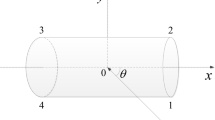Abstract
The underwater object localization is important in defense, underwater biological and environmental applications. Localization using a passive sonar system is a challenging task. It is more challenging when the source and receivers are in the reverberant environment. Time delay estimation (TDE)-based localization is a well-known technique to localize source for last few decades. In this work, empirical mode decomposition maximum likelihood (EMD ML TDE) method is used to estimate the time delay in a reverberant environment. The sound source location is estimated by intersecting spherical surfaces from the time delay. The experimental results prove that EMD ML time delay estimation method is effective to localize a sound source in a reverberant environment.



















Similar content being viewed by others
References
Zhang, C., et al.: Maximum likelihood sound source localization and beamforming for directional microphone arrays in distributed meetings. IEEE Trans. Multimed. 10, 538–548 (2008)
Valin, J.M., Michaud, F., Hadjou, B., Rouat, J.: Localization of simultaneous moving sound sources for mobile robot using a frequency-domain steered beamformer approach. IEEE Int. Conf. Robot. Autom. Proc. 1, 1033–1038 (2004)
DiBiase, J.H., Silverman, H.F., Brandstein, M.S.: Robust localization in reverberant rooms. Microphone Arrays, pp. 157–180. Springer, Berlin (2001)
Argentieri, S., Danes, P.: Broadband variations of the MUSIC high-resolution method for sound source localization in robotics. In: IEEE/RSJ International Conference on Intelligent Robots and Systems. (2007)
Asano, F., Goto, M., Itou, K., Asoh, H.: Real-time sound source localization and separation system and its application to automatic speech recognition. Seventh European Conference on Speech Communication and Technology. (2001)
Duan, R., Yang, K., Ma, Y.: Narrowband source localisation in the deep Ocean using a near-surface array. Acoustics Australia 42(1), 36–42 (2014)
Yang, K., Lu, Y., Lei, Z., Xia, H.: Passive localization based on multipath time-delay difference with two hydrophones in deep Ocean. Acoustics Australia 45(1), 51–60 (2017)
Schau, H.C., Robinson, A.Z.: Passive source localization employing intersecting spherical surfaces from time-of-arrival differences. IEEE Trans. Acoust. Speech Signal Process. 35(8), 1223–1225 (1987)
Wang, H., Chu, P.: Voice source localization for automatic camera pointing system in videoconferencing. IEEE Int. Conf. Acoustics Speech Signal Process. 1, 187–190 (1997)
Omologo, M., Svaizer, P.: Acoustic event localization using a crosspower-spectrum phase based technique. IEEE Int. Conf. Acoustics Speech Signal Process. 2, 273–276 (1994)
Chen, J., Huang, Y., Benesty, J.: Time delay estimation, In: Audio signal processing for next-generation multimedia communication systems. Springer, 197–227 (2004)
Gedalyahu, K., Eldar, Y.C.: Time-delay estimation from low-rate samples: a union of subspaces approach. IEEE Trans. Signal Process. 58(6), 3017–3031 (2010)
Qasaymeh, M.M., Gami, H., Tayem, N., Sawan, M.E., Pendse, R.: Joint time delay and frequency estimation without eigen-decomposition. IEEE Signal Process. Lett. 16(5), 422–425 (2009)
Liang, Y.C., Leyman, A.R.: Time delay estimation using higher order statistics. Electron. Lett. 33(9), 751–753 (1997)
Hinich, M.J., Wilson, G.R.: Time delay estimation using the cross bispectrum. IEEE Trans. Signal Process. 40(1), 106–113 (1992)
Sharma, K.K., Joshi, S.D.: Time delay estimation using fractional fourier transform. Signal Process. 87(5), 853–865 (2007)
Zhou, T., Li, H., Zhu, J., Xu, C.: Subsample time delay estimation of chirp signals using frft. Signal Process. 96, 110–117 (2014)
Lui, K.W., Chan, F.K., So, H.C.: Accurate time delay estimation based passive localization. Signal Process. 89(9), 1835–1838 (2009)
Knapp, C.H., Carter, G.C.: The generalized correlation method for estimation of time delay. IEEE Trans. Acoust. Speech Signal Process. 24(4), 320–327 (1976)
Dhull, S., Arya, S., Sahu, O.: Comparison of time-delay estimation techniques in acoustic environment. Int. J. Comput. Appl. 8(9), 29–31 (2010)
Stephenne, A., Champagne, B.: Cepstral prefiltering for time delay estimation in reverberant environments. Acoustics, Speech, and Signal Processing, ICASSP, 3055–3058 (1995)
Lyon, D.: The discrete fourier transform, part 6: Cross-correlation. J. Object Technol. 9(2), 17–22 (2010)
Carter, G.C., Nuttall, A.H., Cable, P.G.: The smoothed coherence transform. Proc. IEEE 61(10), 1497–1498 (1973)
Roth, P.R.: Effective measurements using digital signal analysis. IEEE Spectr. 4(8), 62–70 (1971)
Hannan, E., Thomson, P.: Estimating group delay. Biometrika 60(2), 241–253 (1973)
Bedard, S., Champagne, B., Stephenne, A.: Effects of room reverberation on time-delay estimation performance. IEEE Int. Conf. Acoustics Speech Signal Process. 2, 261 (1994)
Huang, N. E., Shen, Z., Long, S. R., Wu, M. C., Shih, H. H., Zheng, Q., Yen, N.C., Tung, C. C., Liu, H. H.: The empirical mode decomposition and the hilbert spectrum for nonlinear and non-stationary time series analysis. In: Proceedings of the Royal Society of London A: Mathematical, Physical and Engineering Sciences. 903–995 (1998)
Lei, Y., Lin, J., He, Z., Zuo, M.J.: A review on empirical mode decomposition in fault diagnosis of rotating machinery. Mech. Syst. Signal Process. 35(1), 108–126 (2013)
Kopsinis, Y., McLaughlin, S.: Development of emd-based denoising methods inspired by wavelet thresholding. IEEE Trans. Signal Process. 57(4), 1351–1362 (2009)
Boudraa, A.O., Cexus, J.C.: Denoising via empirical mode decomposition. Proc. IEEE ISCCSP. 4, (2006)
Weng, B., Blanco-Velasco, M., Barner, K.E.: Ecg denoising based on the empirical mode decomposition. Engineering in Medicine and Biology Society. (EMBS06), 1–4 (2006)
Rai, V.K., Mohanty, A.R.: Bearing fault diagnosis using fft of intrinsic mode functions in hilberthuang transform. Mech. Syst. Signal Process. 21(6), 2607–2615 (2007)
Tsypkin, M.: Induction motor condition monitoring: Vibration analysis technique a twice line frequency component as a diagnostic tool. In: IEEE-International Electric Machines Drives Conference (IEMDC), 117–124 (2013)
Mohanty, A.R., Kar, C.: Fault detection in a multistage gearbox by demodulation of motor current waveform. IEEE Trans. Industr. Electron. 53(4), 1285–1297 (2006)
Hyndman, R.J., Koehler, A.B.: Another look at measures of forecast accuracy. Int. J. Forecast. 22(4), 679–688 (2006)
Author information
Authors and Affiliations
Corresponding author
Rights and permissions
About this article
Cite this article
Marxim Rahula Bharathi, B., Mohanty, A.R. Underwater Sound Source Localization by EMD-Based Maximum Likelihood Method. Acoust Aust 46, 193–203 (2018). https://doi.org/10.1007/s40857-018-0129-8
Received:
Accepted:
Published:
Issue Date:
DOI: https://doi.org/10.1007/s40857-018-0129-8



